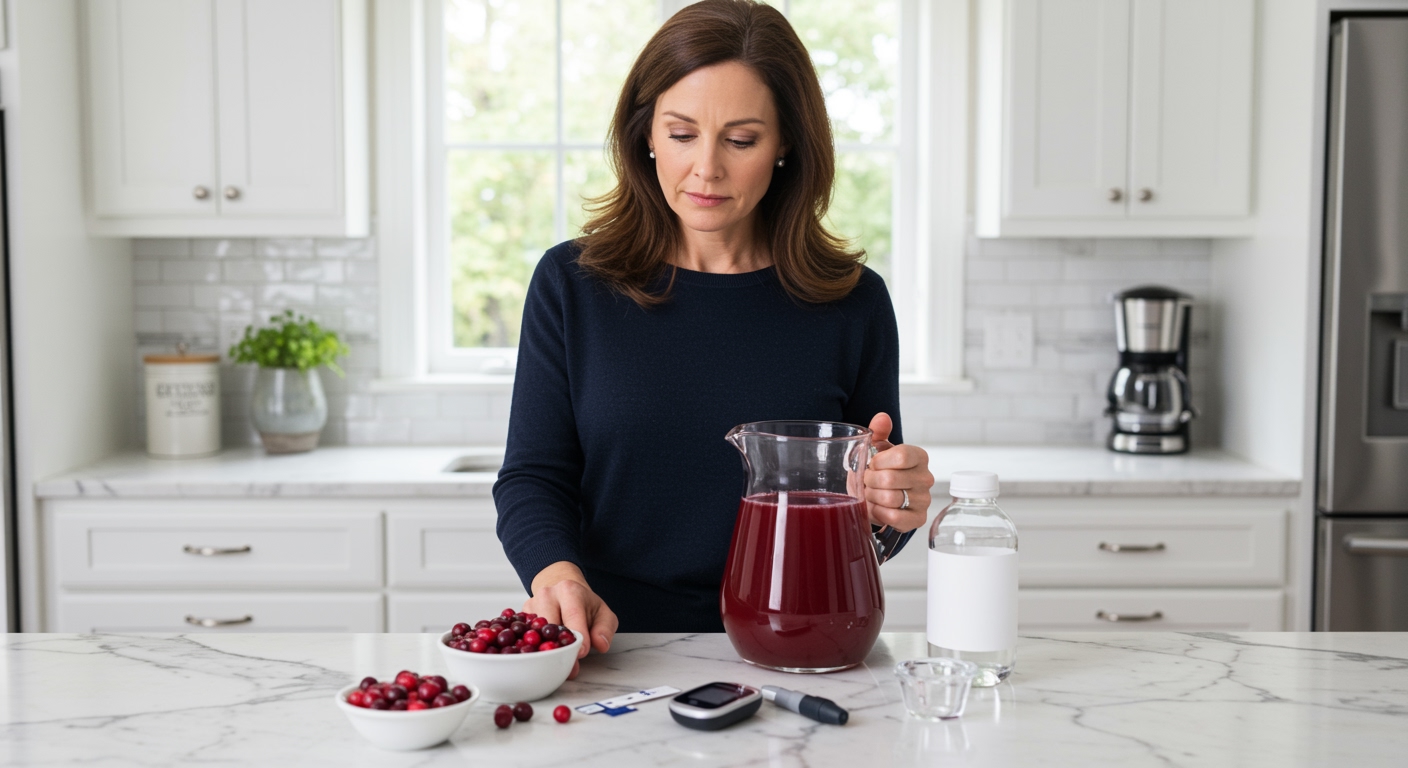✪ Key Takeaway: Most cranberry juices contain high sugar levels that can spike blood glucose, making unsweetened varieties safer for diabetes.
Introduction
You reach for that glass of cranberry juice thinking you are making a healthy choice for your diabetes management.
Many people with diabetes wonder if cranberry juice fits into their meal plan because they hear conflicting information about its health benefits versus sugar content.
Hi, I am Abdur, your nutrition coach and today I am going to explain exactly how cranberry juice affects your blood sugar and whether it belongs in your diabetes-friendly diet.
What Makes Cranberry Juice Different From Other Fruit Juices?
Pure cranberry juice tastes extremely tart and bitter because cranberries contain high levels of tannins and organic acids.
Most commercial cranberry juices add significant amounts of sugar or other fruit juices to make them palatable for consumers.
A typical 8-ounce serving of sweetened cranberry juice contains about 30 grams of carbohydrates, with most coming from added sugars.
This sugar content can cause rapid spikes in blood glucose levels because liquid sugars enter your bloodstream faster than solid foods.
Unsweetened cranberry juice contains only about 12 grams of carbohydrates per 8-ounce serving, making it a better option for blood sugar control.
The glycemic index of sweetened cranberry juice ranges from 45 to 68, which means it can cause moderate to high blood sugar responses.
✪ Pro Tip: Always read ingredient labels because cranberry cocktails often contain less than 10% actual cranberry juice.
How Does Cranberry Juice Affect Your Blood Sugar Levels?
When you drink sweetened cranberry juice, the added sugars cause your blood glucose to rise within 15 to 30 minutes.
Your pancreas responds by releasing insulin to help cells absorb the glucose from your bloodstream.
People with type 2 diabetes often have insulin resistance, meaning their cells do not respond effectively to insulin signals.
This resistance can lead to prolonged elevated blood sugar levels after consuming high-sugar beverages like cranberry juice.
Research shows that liquid calories from fruit juices can cause higher and faster blood sugar spikes compared to whole fruits.
The absence of fiber in juice means there is nothing to slow down sugar absorption in your digestive system.
Studies indicate that people who regularly consume sugar-sweetened beverages have higher risks of developing type 2 diabetes and complications.
✪ Fact: One cup of sweetened cranberry juice can raise blood sugar as much as eating 7 teaspoons of table sugar.
Are There Any Benefits Of Cranberry Juice For Diabetes?
Cranberries contain powerful antioxidants called proanthocyanidins that may help reduce inflammation in your body.
Some research suggests these compounds might improve insulin sensitivity and help your cells respond better to insulin.
Studies show that cranberry consumption may help reduce urinary tract infections, which people with diabetes face more frequently.
The antioxidants in cranberries might also support cardiovascular health by reducing oxidative stress and inflammation.
However, these potential benefits come primarily from the cranberry compounds, not the added sugars in commercial juices.
You can get these beneficial compounds from fresh or frozen cranberries, cranberry supplements, or unsweetened cranberry juice.
✪ Note: The sugar content in most cranberry juices outweighs any potential antioxidant benefits for blood sugar control.
What Are Better Alternatives For People With Diabetes?
Unsweetened cranberry juice mixed with plain water gives you cranberry flavor without excessive sugar content.
Fresh cranberries added to water, sparkling water, or herbal tea provide natural flavor and beneficial compounds.
You can create your own cranberry drink by blending fresh cranberries with water and adding a small amount of stevia or monk fruit sweetener.
Cranberry supplements offer the antioxidant benefits without any impact on blood sugar levels.
If you choose to drink cranberry juice occasionally, limit portions to 4 ounces or less and pair it with protein or healthy fats.
Always check your blood sugar levels before and after consuming any new beverage to understand your individual response.
✪ Pro Tip: Dilute unsweetened cranberry juice with 3 parts water to 1 part juice for a diabetes-friendly option.
The Bottom Line
Most commercial cranberry juices contain too much added sugar to be safe for regular consumption by people with diabetes.
Smart nutrition choices require looking beyond marketing claims to understand how foods actually affect your blood sugar, and cranberry juice is no exception to this rule.
I would love to hear about your experiences with cranberry juice and blood sugar management, so please share your thoughts or questions in the comments below.
References
At NutritionCrown, we use quality and credible sources to ensure our content is accurate and trustworthy. Below are the sources referenced in creating this article:





